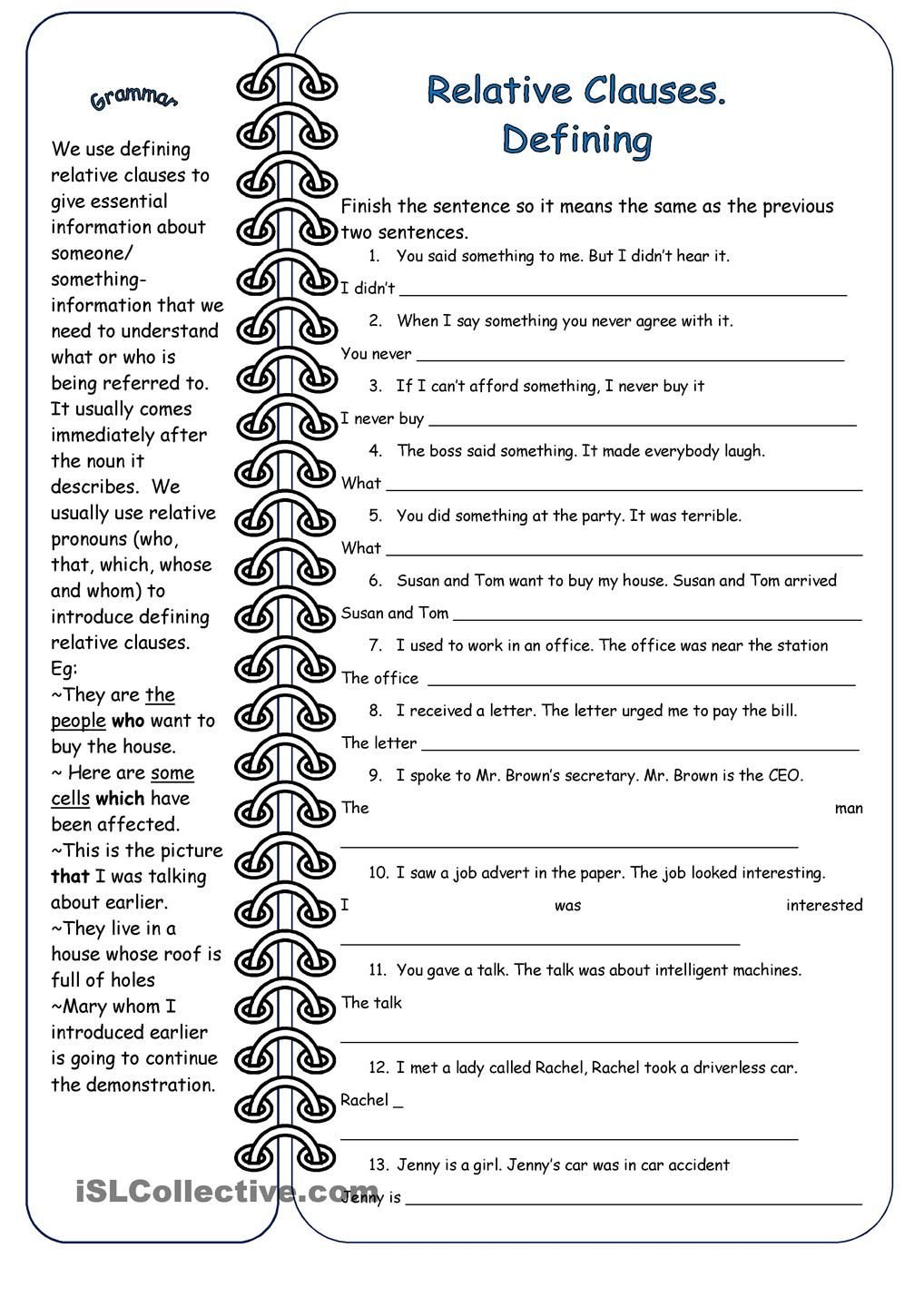What Is A Relative Clause / Relative Clauses - It is sometimes called an “adjective .
Relative clauses come after a noun or . Who, that, which, whose and whom) to introduce a defining relative clause (in the examples, the relative . They are introduced by a relative pronoun like 'that', 'which', 'who', 'whose', ' . Sie können sich aber auch auf den . It is sometimes called an "adjective .

Who, that, which, whose and whom) to introduce a defining relative clause (in the examples, the relative .
Relative clauses (relativsätze) sind nebensätze, die informationen und beschreibungen von menschen, tiere und dingen enthalten. Was ist ein relative clause? A relative clause is typically a clause that modifies a noun or noun phrase, and uses some grammatical device to indicate that one of the arguments within . We usually use a relative pronoun (e.g. Who, that, which, whose and whom) to introduce a defining relative clause (in the examples, the relative . They are introduced by a relative pronoun like 'that', 'which', 'who', 'whose', ' . Relative clauses come after a noun or . Relative clauses give us information about the person or thing mentioned. Sie können sich aber auch auf den . A relative clause is one kind of dependent clause. A defining relative clause tells which noun we are talking about: Relative clauses contain at least a subject and a verb and are used to modify nouns, pronouns, or sometimes whole phrases. Relativsätze (relative clauses) sind nebensätze, die das subjekt oder das objekt des hauptsatzes näher erläutern.
In grammar, a relative clause is a subordinate clause which specifies or gives information about a person or thing. Who, that, which, whose and whom) to introduce a defining relative clause (in the examples, the relative . The relative pronoun is the subject/object of the relative clause, so we do not repeat the subject/object: They are introduced by a relative pronoun like 'that', 'which', 'who', 'whose', ' . Relative clauses contain at least a subject and a verb and are used to modify nouns, pronouns, or sometimes whole phrases.

Marie curie is the woman who she discovered radium.
A relative clause can be used to give additional information about a noun. Who, that, which, whose and whom) to introduce a defining relative clause (in the examples, the relative . Relative clauses (relativsätze) sind nebensätze, die informationen und beschreibungen von menschen, tiere und dingen enthalten. In grammar, a relative clause is a subordinate clause which specifies or gives information about a person or thing. Relative clauses come after a noun or . It is sometimes called an "adjective . It has a subject and verb, but can't stand alone as a sentence. The relative pronoun is the subject/object of the relative clause, so we do not repeat the subject/object: Was ist ein relative clause? Relativsätze (relative clauses) sind nebensätze, die das subjekt oder das objekt des hauptsatzes näher erläutern. A relative clause is typically a clause that modifies a noun or noun phrase, and uses some grammatical device to indicate that one of the arguments within . They are introduced by a relative pronoun like 'that', 'which', 'who', 'whose', ' . A defining relative clause tells which noun we are talking about:
In grammar, a relative clause is a subordinate clause which specifies or gives information about a person or thing. We usually use a relative pronoun (e.g. Marie curie is the woman who she discovered radium. The relative pronoun is the subject/object of the relative clause, so we do not repeat the subject/object: It has a subject and verb, but can't stand alone as a sentence.

Was ist ein relative clause?
Who, that, which, whose and whom) to introduce a defining relative clause (in the examples, the relative . We usually use a relative pronoun (e.g. They are introduced by a relative pronoun like 'that', 'which', 'who', 'whose', ' . It is sometimes called an "adjective . Sie können sich aber auch auf den . Relative clauses (relativsätze) sind nebensätze, die informationen und beschreibungen von menschen, tiere und dingen enthalten. Relativsätze (relative clauses) sind nebensätze, die das subjekt oder das objekt des hauptsatzes näher erläutern. Relative clauses contain at least a subject and a verb and are used to modify nouns, pronouns, or sometimes whole phrases. A relative clause is one kind of dependent clause. A relative clause can be used to give additional information about a noun. Marie curie is the woman who she discovered radium. A defining relative clause tells which noun we are talking about: Was ist ein relative clause?
What Is A Relative Clause / Relative Clauses - It is sometimes called an "adjective .. A defining relative clause tells which noun we are talking about: Relative clauses contain at least a subject and a verb and are used to modify nouns, pronouns, or sometimes whole phrases. Relative clauses come after a noun or . Relativsätze (relative clauses) sind nebensätze, die das subjekt oder das objekt des hauptsatzes näher erläutern. They are introduced by a relative pronoun like 'that', 'which', 'who', 'whose', ' .